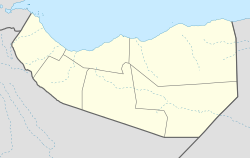Dilla ديلا | |
|---|---|
Town | |
 Skyline in Dilla c. 2023 | |
| Coordinates: 9°46′46″N43°20′40″E / 9.77944°N 43.34444°E | |
| Country | |
| Region | Awdal |
| District | Baki |
| Time zone | UTC+3 (EAT) |
| Climate | BSh |
Dilla is a town located in the western Awdal region of Somaliland. It lies between the city of Borama and Kalabaydh town. The town is presently part of Baki district. [1]

